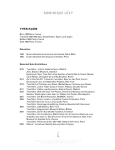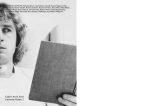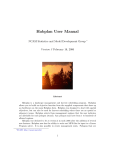Download Alan Wood: Un tableau hybride du paysage de la Côte du
Transcript
Article "Alan Wood: Un tableau hybride du paysage de la Côte du Pacifique / Alan Wood: A Hybrid View of the Pacific Landscape" Arthur Perry Vie des Arts, vol. 22, n° 89, 1977-1978, p. 38-96. Pour citer cet article, utiliser l'information suivante : http://id.erudit.org/iderudit/54861ac Note : les règles d'écriture des références bibliographiques peuvent varier selon les différents domaines du savoir. Ce document est protégé par la loi sur le droit d'auteur. L'utilisation des services d'Érudit (y compris la reproduction) est assujettie à sa politique d'utilisation que vous pouvez consulter à l'URI https://apropos.erudit.org/fr/usagers/politique-dutilisation/ Érudit est un consortium interuniversitaire sans but lucratif composé de l'Université de Montréal, l'Université Laval et l'Université du Québec à Montréal. Il a pour mission la promotion et la valorisation de la recherche. Érudit offre des services d'édition numérique de documents scientifiques depuis 1998. Pour communiquer avec les responsables d'Érudit : [email protected] Document téléchargé le 16 novembre 2015 07:25 Alan Wood Un tableau hybride d u paysage de la Côte d u Pacifique Art Perry L'art est une harmonie parallèle à la nature 1 . (PAUL CÉZANNE) On peut soutenir avec beaucoup de justesse que Cézanne fut le dernier grand peintre paysagiste. Le vingtième siècle a fort peu encouragé la poursuite de l'étude des préoccupations qu'apporte l'art du paysage, si bien que l'œuvre de Cézanne apparaît comme le dernier état qui a précédé l'arrivée des problèmes de contenu qui caractérisent le cubisme et conduisent directement à l'art encore plus hermétique de l'actuelle après-guerre. En réalité, cette évolution a provoqué la mise de côté du paysage dans l'art contemporain. En général, l'art de l'après-guerre s'est défini comme un jeu incestueux de descriptions personnelles aboutissant au vide stérile du minimalisme. Ainsi, des artistes comme Donald Judd, Cari André ou Sol Lewitt se sont enfermés entre les quatre murs de la galerie d'art pour obéir à ses lois de l'espace et ont consciemment rejeté toute référence au monde naturel. Même l'Art pop, l'opposé de l'Art minimal, n'était qu'une expression strictement urbaine qui ne pouvait absolument pas contribuer à alimenter une créativité fondée sur le paysage. Pourtant, le paysage a récemment refait son entrée dans l'actualité artistique. A nouveau, les artistes ont permis à l'image naturelle associative de devenir leur thème. Au Canada, Roald Nasgaard, conservateur de l'art contemporain à l'Art Gallery of Ontario, a évalué avec justesse le retour de la sensibilité en ces termes: «On dirait presque que la nouvelle méthodologie de l'art et son champ d'activité, considérablement élargi, ont permis une reviviscence de l'intérêt porté à l'environnement naturel» 2 . Il semble assez logique que le Canada ait manifesté un intérêt renouvelé pour l'art paysagiste. En effet, où, sinon dans l'un des pays qui offrent la plus grande étendue au monde de paysage naturel intact, peut-on espérer voir des artistes effectuer un retour à la nature ? Au Canada, le paysage devient réellement une expression artistique importante, et les artistes de la Côte du Pacifique sont très sensibles à leur imposant environnement. Les arches que forment les sapins de Douglas, la hauteur imprécise des montagnes environ38 nantes, l'horizon immense de l'océan Pacifique n'offrent-ils pas des images idéales à un paysagiste? Parmi les artistes de la Côte qui s'essaient à rendre la majesté du Pacifique, un personnage se distingue des autres: Alan Wood. Originaire de Widnes en Angleterre, il semble le protagoniste des Constructivistes de la Côte, un groupe d'artistes de la Colombie britannique qui, par leurs œuvres plastiques, interprètent le paysage de l'Ouest (Richard Prince est généralement reconnu comme tenant le second rang dans ce groupe 5 ). Né en 1935, Alan Wood est l'aîné de plusieurs des membres du Groupe. De plus, contrairement à d'autres artistes de la région, il a acquis par ses voyages une expérience personnelle dans des centres artistiques comme New-York, Londres et London, Ontario, qui lui a apporté une sensibilité artistique fortement variée mais complexe. L'esthétique de Wood est aussi confuse que ses collages sur toile. Anthony Caro, Richard Smith, Jackson Pollock, Robert Rauschenberg et Jean Dubuffet ont tous influencé Wood. Cela ne signifie pas que Wood a fait un effort conscient pour suivre la trace de ces artistes, mais que certains éléments du style personnel de chacun d'eux se sont fusionnés à l'expression esthétique personnelle de Wood. Anthony Caro est peut-être l'exemple le plus évident d'un artiste que Wood a analysé et assimilé dans le but de découvrir le fonctionnement intime de sa singulière grandeur. Caro est le maître de la tension sculpturale. De ses meilleures œuvres ressort une animation de la forme et de l'espace qui attire et oriente le spectateur dans toutes les directions. Comme Michael Fried l'a noté au sujet des sculptures de Caro: «Elles s'ouvrent ou s'élèvent ou se suspendent ou s'étalent ou se tournent ou se plient ou s'étirent ou s'étendent ou s'éloignent. . . , soit des caractérisations de la signification abstraite d'œuvres individuelles et non de ce que l'on pourrait appeler leur présence réelle» 4 . Fried suggère, avec raison d'ailleurs, que les sculptures de Caro expriment leurs tensions par des relations qui jouent entre des forces dynamiques particulières plutôt que par une image ou un objet. Les œuvres de Caro possèdent, en effet, une syntaxe très développée. Lorsque Alan Wood a vu la grande exposition de Caro à la Galerie David Mirvish, à Toronto, en juillet 1971, il a été beaucoup frappé par cette syntaxe de tensions. Wood examina en particulier le travail de l'œuvre intitulée Nocturne et exécutée par Caro en 1970. Wood comprit la tension structurale interne de cette œuvre et l'appliqua a ses œuvres constructivistes plus élaborées des dernières années. Ce n'était cependant pas la première fois que Wood voyait des œuvres de l'artiste anglais. Quelques années plus tôt, à Londres, il avait étudié Prairie, œuvre définitive réalisée en 1967. La tension structurale de Prairie est centrée sur la suspension: quatre barres horizontales semblent pendre ou être suspendues dans l'espace. On retrouve la même instabilité dans deux œuvres trapézoïdales récentes de Wood, Suspended Lake (Quamichan) I et Suspended Lake (Quamichan) II, toutes deux produites en 1977. Une étude parallèle des Suspended Lake de Wood et de Prairie de Caro permettent de bien juger la méthode de travail particulière de Wood. Tout comme Caro avec sa syntaxe structurale, Wood crée, par un langage interne, un dialogue vivant entre son art et son auditoire. Ni Prairie ni les 1. Alan W O O D Cathedral (Sasamat), 1977 (œuvre en cours d'exécution). (Phot. Arthur Perry) Art actuel Suspended Lake ne sont des œuvres d'art statiques ou stationnaires. Elles dirigent la perception du spectateur vers les domaines de l'incertitude. Ainsi, la bande qui supporte les lacs flottants de Wood provoque un effet de tentative de stabilité ou d'arrêt d'action momentané. Tout comme, dans Prairie, on perçoit l'équilibre limité des barres horizontales, de même les lacs de Wood sont en équilibre précaire. Une tension suspendue de cette sorte apporte comme résultat une activité dynamique à Prairie et aux lacs, et les paysages de l'un et l'autre semblent grandement animés. Si Caro a conduit Wood à la syntaxe interne des tensions structurales, Richard Smith, de son côté, a permis à Wood d'entrevoir la toile peinte comme instrument sculptural. En 1963, Smith a tenu une importante exposition de constructions de toile saillante à la Galerie Kasmin de Londres. Alan Wood a visité cette exposition et se souvient encore de l'emplacement de certaines œuvres et de la grande impression que lui avait causé une œuvre exceptionnelle, Piano, exécutée en 1963. Pour de multiples raisons, cette année fut importante pour Wood. En 1963, il présenta une exposition individuelle à la Galerie d'art de Wakefield City. De plus, il remporta, cette annéelà, le premier prix à l'Arnolfini Open Exhibition, à Bristol. L'exposition de Smith à la Galerie Kasmin arriva en pleine période de bouleversement et ajouta énormément à la perception picturale de Wood en ce qui concerne l'échelle de grandeur et la construction. Au sujet de la production artistique totale de Smith, Barbara Rose affirma, en 1975, que «les toiles façonnées de Smith sont peut-être volumineuses et encombrantes mais toujours propres et bien taillées. Ses récentes séries de toiles sans châssis s'éloignent peut-être des normes établies mais ne sont jamais négligées» 5 . Une telle observation s'applique également à Alan Wood. Lui aussi présente une certaine gaucherie qu'il semble conserver dans ses collages sur toile sans châssis. C'est sans cérémonie mais rafraîchissant. Cependant, il serait beaucoup trop facile d'affirmer simplement que Smith a énormément influencé Alan Wood. En effet, Smith est toujours demeuré exceptionnellement prudent et ordonné, tandis que Wood a acquis un goût pour le hasard pictural fort éloigné du calcul précis de Smith. Comme Caro, Smith a participé par sa sensibilité artistique à l'esthétique personnelle tâtonnante de Wood. Ce que Wood a pu prendre chez Smith, c'est un sentiment de liberté sculpturale par rapport à la surface peinte. Cependant, la manière dont chaque artiste applique cette forme sculpturale à son art varie grandement. En comparaison, les récents cerfs-volants de Smith tels Liverno et Maczone, tous deux exécutés en 1972, semblent même moins aventureux au point de vue spatial, que Piano, par exemple. En raison de leur couleur amortie et de leur réseau ordonné de ficelles, Liverno et Maczone sont plus raffinés mais sûrement moins sensationnels au point de vue sculptural, que plusieurs de ses œuvres des années soixante. Wood, par exemple, a poussé son art dans des domaines qui conduisent progressivement au risque et au hasard. A titre de comparaison, considérons l'œuvre de Wood intitulée Tree Slope (Nootka) et qui date de 1977. Comme pour les cerfs-volants de Smith, Tree Slope utilise la ficelle comme élément de travail. Cependant, l'artiste l'utilise comme instrument textural de libre expression. La ficelle traverse en toute liberté peinture épaisse et morceaux de bois pour devenir un 40 élément actif plutôt que structural de l'œuvre. Bien sûr, on perçoit facilement l'influence de Smith dans Tree Slope par les panneaux de toile qui se chevauchent et par le façonnage de la toile en énoncé sculptural — cependant, à l'heure actuelle, Wood s'approprie les premières idées de Smith plutôt que d'y prendre appui. En février dernier, Alan Wood a exposé simultanément, dans deux galeries d'art de Vancouver, ses nouvelles œuvres fondées sur la puissance du paysage de la Côte du Pacifique. La Galerie de Pender Street logeait les œuvres les plus considérables de l'artiste, y compris Suspended Lake (Quamichan) et Tree Slope (Nootka) mentionnées plus haut. La Galerie Equinox, de son côté, présentait une série de nouveaux collages intitulée Trails (Bella Coola). Avec cette double exposition, Wood se classe à la tête des paysagistes de la Côte du Pacifique. Les anciens maîtres de l'environnement du Pacifique, tels Toni Onley et Gordon Smith, semblent maintenant étriqués et trop prudents à côté des ouvrages actuels de Wood. Toutefois, ce n'est qu'en 1970 que Wood pris pour la première fois connaissance des énormes dimensions du paysage de la Colombie britannique lorsqu'il vint à l'Université de Victoria à titre d'artiste invité. Dans le passé, les collines gracieuses du Devon et du Cornwall, en Angleterre, et le paysage gallois dans lequel il vécut de 1966 à 1973, alors qu'il donnait des conférences au College of Art de Cardiff, constituaient sa principale source de référence visuelle. Son voyage en Colombie britannique, en 1970, lui fit connaître une nouvelle puissance des formes et de la croissance naturelle. Lorsque Wood quitta son poste de conférencier et vint, à titre d'artiste invité, à l'Université de Cincinnati, en janvier 1974, il s'empressa de prendre les dispositions requises pour retourner dans la région de la Côte nord-ouest du Pacifique. 2. Alan WOOD dans son atelier de Vancouver. De g. à dr.: Cat's Cradle (Squamish), Cathedral (Sasamat) et Three Slope (Nootka), 1977. (Phot. John Denniston) 3. Cat's Cradle (Squamish), 1977. Matériaux divers. (Phot. Ross Kenwood) 4. Cowichan, 1976. 5. Alan WOOD devant Suspended Lake (Quamichan II), 1977 (œuvre en cours d'exécution). (Phot. Robert Keziere) A r t actuel Puis, plus tard dans l'année, il s'installa enfin à Vancouver. Si l'on étudie la transformation de l'art de Wood depuis son introduction au paysage qui entoure Vancouver, on remarque une augmentation de rudesse et un durcissement de toute son approche vis-à-vis la nature. Dans ses œuvres plus récentes, une dimension physique nouvelle est visible. On la retrouve tout d'abord dans les constructions en collage intitulées Cowichan et Shawnigan, produites l'an dernier. Dans ses dernières œuvres, Wood fusionne, en de grands collages, des morceaux de toile et d'idées. Il lie broche, texture, ficelle, peint, applique et exprime son sentiment avec une grande énergie. Le nombre d'influences qu'il a maintenant assimilées dépasse grandement celles de Caro et Smith. Son souci de la texture révèle la présence substantielle des œuvres actuelles de Jules Olitski et de Larry Poons. A une époque, Wood admirait la texture de l'art brut de Jean Dubuffet; maintenant son intérêt se porte dans toutes les directions. Pourtant, au-delà de tout et quelque direction qu'il emprunte, il conserve toujours dans son art vitalité et force expressive. La peinture ne lui sert pas à dessiner mais plutôt d'instrument à rendre la texture. Seuls la coupe et le façonnage finals des panneaux de toile permettent de définir ses surfaces peintes. Cette méthode ressemble beaucoup à ce qu'Irving Sandler a noté au sujet de l'expressionnisme pictural de Jackson Pollock: «La ligne fluide de Pollock était originale non seulement par la façon directe dont elle était appliquée mais parce qu'elle ne définissait pas des images et ne découpait pas des plans — deux fonctions traditionnelles du dessin» 6 . Ainsi, tout comme Pollock, Wood considère que peindre est un acte qui crée de l'espace plutôt qu'il ne se borne à remplir un espace déterminé. Les œuvres d'Alan Wood de 1977 poussent à l'extrême l'idée d'aplat de Pollock. A son avis, des œuvres comme Cat's Cradle (Squamish) élargissent l'espace et l'échelle de grandeur. Avec son grand panneau d'ocre et ses panneaux latéraux d'un bleu noir tourbillonnant, Cat's Craddle s'étend sur une largeur totale de vingt pieds. Cette échelle de grandeur permet une saturation de la perception du spectateur inégalable dans aucune œuvre antérieure de Wood. Comme dans les Suspended Lake qui l'accompagnent, la perspective aérienne aide également à aplanir l'image naturaliste de Cat's Cradle en d'audacieux motifs géométriques. Cette pièce de vingt pieds, conçue d'après un barrage de billots flottant sur le détroit de Howe, utilise également l'effet de suspension des deux œuvres représentant des lacs. L'art de Wood présente un entrecroisement d'idées, de perceptions, de styles, de variations et d'expériences personnelles. Pourtant, parmi toute cette abondance de ressources, Wood considère l'une d'elles comme la plus profonde pour son engagement artistique total. Il mentionne la rétrospective de Robert Rauschenberg, en 1964, à la Galerie de Whitechapel, à Londres, comme une expérience décisive dans l'édification de sa propre esthétique. Chez Rauschenberg, il a perçu jusqu'à quelles limites un artiste peut aller tout en préservant la cohésion de son œuvre. Il comprit, en outre, que le collage constitue une technique aux possibilités constructives illimitées et que des matériaux, jamais utilisés antérieurement dans un contexte artistique, peuvent accéder au domaine des beaux-arts. Une déclaration de Rauschenberg, faite à l'époque de sa rétrospective de Londres, nous éclaire sur ce que Wood a pu découvrir dans les premières combinaisons de {'enfant terrible américain. «J'ai toujours eu le sentiment que, quoique j'aie fait et quoique j'aie utilisé, le mode d'emploi était invariablement plus près d'une collaboration avec les matériaux que de quelque manipulation et maîtrise conscientes que ce soit» 7 . Pour Wood, également, une collaboration avec les qualités intrinsèques des matériaux utilisés est essentielle à son rendu du paysage. Ainsi, comme cela s'est produit à l'égard de Caro, Smith, Pollock et Dubuffet, Wood a ajouté à sa propre sensibilité hybride, la vision personnelle de Rauschenberg. A l'heure actuelle, il est trop tôt pour conjecturer l'importance réelle de Wood dans la reviviscence de l'art paysagiste canadien. On ne peut toutefois nier le sentiment de lieu et d'urgence qui se dégage des présentes œuvres paysagistes de cet artiste. 1. Roger Fry, Cézanne: A Study of his Development. Londres, The Noonday Press, Inc., 1958, p. 1. 2. Roald Nasgaard, Root and Promise — Changing Visions: The Canadian Landscape, Toronto, Art Gallery of Ontario, 1976, p. 12. 3. Voir l'article paru dans Vie des Arts, Vol. XXI, N " 85, p. 70-73. 4. Michael Fried, Anthony Caro. Londres, 1969, p. 11. 5. Barbara Rose, Richard Smith: Seven Exhibitions 1961-75. Londres, Tate Gallery, p. 7. 6. Irving Sandler, The Triumph of American Paintings: A History of Abstract Expressionism. New-York, Praeger Publishers, Inc., 1970, p. 14. 7. Calvin Tomkins, The Bride and the Bachelors: The Heretical Courtship in Modern Art. Londres, Weidenfield et Nicolson, 1965, p. 204. \ / | (Traduction de Marie-Sylvie Fortier-Rolland) English Original Text, p. 95 41 work, that of his murals, in which are to be found complex plays similar to those that animate his easel paintings, plays of the mind allowing the artist to represent, in a symbolic translation at once critical and humorous, his vision of certain profound impulses of modern civilization; the chief of these impulses could approximately (while not losing sight of the artist's humorous, even ironical characteristic) amount to that of the reluctant relationship between mechanical hardware (tie-rods, gears, etc.) and the software of electronics, and also that of the ambiguous connection between ancient man (the man of organic sexuality) and future man (cybernetic robot); through this pair of deep impulses (Eros3, we could say, parodying Montpetit's triptych Amourf), the artist always seems mainly preoccupied by the lines of communication between man and the universe, between the individual and society, between the actual and the imagined, between the awareness of the individual and the collective unawareness in which he is bathing — but this is not the place to examine closely the semiotic and dialectical components of the aesthetics that gives Montpetit's work all its complex substance, meticulously combined in the wedding of the plastic and the symbolic, according to a curious comprehension of artistic form blossoming into planned delight. Montpetit proves himself more and more a lavish image-maker of present-day experience, of the present time, rather in the sense of Pierre Henry's Messe pour le temps présent. Is there not also a sort of plastic liturgy in Montpetit's work, thanks to which the instinctive sexual impulse becomes erotic and aesthetic, civilized and coded, in short becomes symbolized according to a formal regenerating transformation whose fruitful and open syntax would not be capable of reducing itself to the simple question of the integration of art into urban décor? A series of murals Since the large diptych painted in 1971 on the walls of houses on each side of Notre-Dame St. near Saint-Remi St. in the Saint-Henri ward of Montreal, Guy Montpetit has been pursuing the development of his public work while giving his attention to the function of the work of art in the urban fabric at the same time as to relevant technical research, without, however, reducing any part of his inventive independence or of his stylistic profile. In 1972 Montpetit set up an important mural in relief in the west hall of Radio-Canada's new Montreal building, using all the funds alloted to the material creation and the installation of the work; in accordance with his original conception, this mural was to be animated by programmed lighting, which the allocated budget forbade, and it was only five years later, in the summer of 1977, that the composition would be modified and the artist would finally be able to give it the luminous throbbings initially planned. In 1972-1973 Montpetit signed an impressive mural in triptych in the ventilation shaft of the Ville-Marie autoroute at Montreal; this production gave the artist the opportunity of working closely with the Domtar Company's laboratories, arborite department, which allowed him to integrate the elements of his chromatic language into a range of laminated materials coloured in the mass; the painter thus became truly a conceiver of plastic forms, an architect of works which were then produced following his plans and specifications, thanks to techniques of very great precision and according to a vast gamut of possibilities, open as much to surfaces of small size eventually made in series numbered like prints as to partially modular reliefs of 10 by 70 feet, like the one in the ventilation shaft in Vitré St., in the metropolitan centre, executed for the Lavalin Group. In 1974-1975, in the environment that he planned for the L'Assomption subway station in Montreal, Guy Montpetit again resorted to the technique of arborite coloured in the mass, but this time in large flat frescoes artfully adapted to their use since these surfaces, without losing anything of their chromatic brilliance and their rhythmic vigour are, for all practical purposes, unalterable and of the simplest possible maintenance. In the summer of 1976 Montpetit participated in the Corridart programme of sad and very short memory, with collapsible sculptural forms; he also sketched a discothèque project, but he concentrated mainly on the building of a chapel in Sainte-Clotilde parish in the Saint-Henri ward in Montreal; there he was involved in an exciting global work, since the artist-conceiver decided all its plastic: forms and colours, rhythms and proportions, floors and ceilings, walls and furnishings, and even liturgical objects. As I write these lines, in mid-September 1977, the Sainte-Clotilde chapel is almost finished and Montpetit is collaborating closely with the Mercier architects on the establishing of the chromatic programme of the Victor-Doré institute for the handicapped, which will soon be built in Montreal East; naturally, it is of this work on hand that the artist speaks most spontaneously, of this "little city", as he says, where the psychology of colour asserts its rights even into signs and mechan- ical systems, presenting them in corridors and in chromatic ramps; and Montpetit forewarns us that if he is excited by enthusiasm and instigates floods of colour, the surplus will be effectively absorbed by the restrained, functional architectural masses. So this is the point at which Guy Montpetit has arrived, in a few paragraphs that would have to be much more developed to do justice to the singularly dynamic and inventive evolution of his work, as much on his easel at Val-David as along the thread of a series of murals which are already important among the best of the Montreal school. (Translation by Mildred Grand) ALAN WOOD: A HYBRID VIEW OF THE PACIFIC LANDSCAPE By Arthur PERRY L'art est une harmonie parallèle à la nature.* (Paul Cézanne) It can be argued, and with much validity, that Cézanne was our last truly great landscape artist. The twentieth-century has done little to promote a continuance of the landscape concerns of art in any major manner, and Cézanne can be seen as the last step before Cubism's more internal concerns that lead directly into the even more internally hermetic art of the present post-war period of our history. What this has meant, in effect, is the avoidance of landscape in contemporary art. Post-war art has been for the most part an incestuous game of self-definition that has ended within the sterile vacuum of Minimalism. Artists such as Donald Judd, Carl André or Sol Lewitt cornered themselves into the four walled dictates of gallery space and consciously shut out any reference to the natural world. To compound the problem, even Minimal Art's antithesis, Pop Art, was a strictly urban-based expression which in no way helped to generate any landscape-based creativity. Yet recently the landscape has again re-entered the forum of mainstream art. Artists have allowed the associative natural image to once more become their statement. In Canada, this renewed sensibility has been accurately assessed by Roald Nasgaard, Curator of Contemporary Art at the Art Gallery of Ontario: "It would almost appear that the changing methodology of art and its considerably broadened scope of operations have allowed the revitalization of interest in the natural environment" 2 . It seems only logical that Canada would foster a renewed interest in landscape art. For where else but in a country with one of the largest expanses of untained natural landscape in the world could one hope to see artists turning back to nature? In Canada, where the landscape is indeed becoming a major art expression, artists on the West Coast are most susceptible to their imposing surroundings. The arching Douglas firs; the looming hulk of the encircling mountains; the open breadth of the Pacific Ocean — is this not the ideal imagery for any landscape artist? As West Coast artists grapple with Pacific grandeur, one figure among them stands apart: Alan Wood. Wood, who originally hailed from Widnes, England, appears to be the leading exponant of the so-called Coastal Constructivists (a group of British Columbian artists who interpret the Western landscape into sculptural statements, Richard Prince being the most recognized of the others in this group3). Alan Wood, born in 1935, has seniority over many of the younger Coastal Constructivists. His travelling has also given him a feed-back of personal experience from art centres such as New York and London (both England and Ontario), not encountered by other West Coast artists. What this has done for Wood is to formulate an intensely diverse, but complex, artistic sensibility. Wood's aesthetic is as pell-mell as his canvas collages. Anthony Caro, Richard Smith, Jackson Pollock, Robert Rauschenberg and Jean Dubuffet all have a trail through Wood's art. This is not to say Wood has made a conscious effort to retrace the steps of these artists, but elements of each artist's personal style has been fused into Wood's own aesthetic. Anthony Caro is perhaps the clearest example of an artist whom Wood scrutinizes and digests in an attempt to find the inner workings of that artist's singular greatness. Caro is the master of sculptural tension. Within the best Caro works lies an animation of form and space which 95 pulls and pushes the viewer's orientation in all directions. As Michael Fried noted, in reference to Caro's sculptures: "They open, or rise, or suspend, or spread, or turn, or bend, or stretch, or extend or recede . . . understood as characterizations of abstract meaning of individual works, not of anything that might be called their literal presence" 4 . What Fried is suggesting, and rightly so, is that Caro's sculptures express their working tensions through inter-relationships of particular dynamics, rather than through an overall image or object. In effect, Caro's works have a well-developed syntax. It is this syntax of tensions which appealed to Alan Wood when he viewed the large Caro exhibition at the David Mirvish Gallery in Toronto, in July 1971. In particular, the workings of Caro's Nocturne, 1970, were studied by Wood. What developed in Wood's own aesthetic was an understanding of internal structural tension which he later applied to his larger constructivist works of the past few years. Yet the Toronto exhibition of Caro was not the first time Wood had seen works by the British sculptor. Years before in London, England, Wood had viewed Caro's definitive Prairie, 1967. The structural tension of Prairie is centred on suspension: four horizontal bars appear to hang or be suspended in space. This same instability is carried into Wood's two recent trapezoid works, Suspended Lake (Quamichan) I and Suspended Lake (Quamichan) II, both from 1977. To parallel Wood's Suspended Lake pieces to Caro's Prairie allows a closer evaluation of Wood's particular modus operandi. Similar to Caro's structural syntax, Wood has an internal language to create an active dialogue with his art and his audience. Neither Prairie nor the Suspended Lake pieces are static or stationary works of art. They push the viewer's perception into areas of uncertainty. For instance, the strapping that supports Wood's free-floating lakes generates a sense of tentative stability or momentary stop-action. Just as Prairie's horizontal bars are realized as being in finite balance, so Wood's lakes are likewise precariously placed. The result of such suspended tension is that Prairie and the lakes become dynamically activated, and the landscape concerns of each appear highly animated. If Caro has led Wood to the internal syntax of structural tensions, Richard Smith has allowed Wood to see painted canvas as a sculptural device. In 1963 Smith had an influential exhibition of jutting canvas constructions at London's Kasmin Gallery. Alan Wood viewed this show and remembers to this day where certain works were placed, and how impressed he was by Smith's exceptional work, Piano, 1963. This was an important year in many ways for Alan Wood. In 1963 he had a oneman exhibition at Wakefield City Art Gallery. It was also the year Wood won first prize in the Arnolfini Open Exhibition, Bristol. Smith's Kasmin show came in the midst of all change, and it did much in adding to Wood's painterly perception of scale and construction. Speaking on the total production of Smith's art, Barbara Rose stated in 1975 that Smith's "shaped canvases may be bulky and awkward but they are always tidy and well-tailored; his recent series of stretcherless canvases may be informal but they are never sloppy or tacky" 5 . Such an observation relates jointly to Alan Wood. Wood too has a seemingly unabandoned awkwardness in his stretcherless canvas collages that results in an informal but fresh quality. Yet it is far too easy to merely state that Smith is a major influence on Alan Wood's art. For Smith has always been exceptionally cautious and ordered, while Wood has developed a sense of painterly chance that holds little of Smith's precise calculation. As with Caro, Smith's artistic sensibility added to Wood's groping personal aesthetic. What Wood was able to cull from Smith was a sense of sculptural freedom in relation to the painted surface. The manner in which each artist applies this sculptural form to his art varies greatly, though. By comparison, Smith's recent kite pieces, such as Livorno, and Maczone, both from 1972, seem to be even less adventurous spatially than, say, Piano. Low-keyed colour and an ordered grid of strings make Livorno and Maczone more polished but certainly less exciting sculpturally than many of his earlier works in the Sixties. Wood, on the other hand, has pushed his art into areas that progressively lead to risk and chance. Wood's Tree Slope (Nootka), 1977, can be entered for comparison. Like Smith's kites, Tree Slope has string as a working element. But Wood uses string as a freeform textural device. Unordered and lacing through heavy paint and wood chips, Wood's string becomes an active rather than a structural element in his art. Certainly Smith's influence underlies much of Tree Slope; the overlapping panels of canvas; the shaping of the canvas into sculptural statement — but Wood is now incorporating rather than relying on Smith's earlier ideas. This past February Alan Wood filled two Vancouver galleries simultaneously with new works based on the force of the West Coast landscape. The Pender Street Gallery housed his largest works to date (including the forementioned Suspended Lake (Quamichan) works and Tree Slope (Nootka), while the Equinox Gallery presented a series of new 96 collages entitled, Tra;7s (Bella Coola). This joint exhibition places Wood at the forefront of West Coast landscapists. Past masters of the Pacific environment, such as Toni Onley and Gordon Smith, now appear tight and all too safe beside Wood's present works. Yet it was only in 1970, as artist-visitor to the University of Victoria, that Wood first encountered the immense proportions of the British Columbian landscape. Before then his principal source of visual reference was the subtle hills of Devon and Cornwall, England, and the Welsh landscape he lived with from 1966 to 1973 while he was a lecturer at Cardiff College of Art. But his 1970 trip to British Columbia opened his eyes to a new force of natural forms and growth. When Wood left his Cardiff post and became a visiting artist at the University of Cincinnati in January 1974, he wasted no time in making arrangements to return to the Pacific Northwest. Later that year he finally moved to Vancouver. Viewing the transition in Wood's art since his introduction to the landscape surrounding Vancouver, one notices an increased ruggedness in its handling and a toughening-up of Wood's whole approach to nature. A new physicality has taken over in Wood's more recent works, that was seen first in his Cowichan and Shawnigan torn-collage constructions of last year. Wood's new works are large collaged fusions of sectioned canvas and sectioned ideas. He binds, staples, textures, strings, paints, applies and expresses his way into an open energy. The number of influences he now has distilled reach far beyond Caro and Smith. Wood's textural concerns have the substantial presence of the current works by Jules Olitski and Larry Poons. At one time Wood admired the Art Brut texture of Jean Dubuffet, but to-day it goes in all directions. Yet above all else, whatever way Wood's art seems to spread, he always keeps a vitality and expressiveness in his art. Wood does not draw with his paint, but handles it as a textural device. Only his final cutting and shaping of the canvas panels allow definition to his painted surfaces. This is a close ally to what Irving Sandler noted of Jackson Pollock's own painterly expressiveness: "Pollock's fluid line was unconventional not only because of the direct manner in which it was applied, but because it did not define images or outline planes — two traditional functions of drawing" 6 . So, similar to Pollock, Wood views painting as an act of creating space, rather than confining the painting activity to filling in a predesigned space. Alan Wood's works of 1977 carry Pollock's idea of flatness to a personal extreme. For Wood, works such as his Cat's Cradle (Squamish), 1977, enter a new breadth of space and scale. With its large central panel of ochre, and its side panels of swirling blue-black, Cat's Cradle has a total expanse of twenty feet. This scale allows a saturation of the viewer's perception unlike any previous work by Wood. As in the accompanying Suspended Lake pieces, and aerial perspective also helps to flatten out the naturalistic imagery of Cat's Cradle into bold geometric patterns. Conceptually derived from the floating log-booms on Howe Sound, this twenty-foot work also employs the suspension device of the two lake pieces. Wood's art is a interlacing of ideas, perceptions, styles, variations and personal experiences. Yet of all of his backlogged resources, Wood sees one as being the most profound to his total involvement in art. Wood cites the 1964 retrospective of Robert Rauschenberg at London's Whitechapel Gallery as a major moment in building his personal aesthetic. In Rauschenberg, Wood saw the limits to which an artist could apply himself and still hold together. In Rauschenberg, too, he saw collage as an element of extreme constructive potential, and he saw materials outside of any past art context being corralled into the fine art forum. A statement by Rauschenberg from the same time as his London retrospective gives light to what Wood was able to see in the American enfant terrible's early combines: "I've always felt as though whatever I've used and whatever I've done, the method was always closer to a collaboration with materials than any kind of conscious manipulation and control" 7 . For Wood, too, a collaboration with the inherent qualities of his materials is essential to his final landscape statement. So, like Caro, Smith, Pollock and Dubuffet, Rauschenberg's personal vision has become part of Wood's own hybrid sensibility. The total importance of Alan Wood to the revitalization of Canadian landscape art can only be speculated on at this premature date. But there is a sense of place and urgency to Wood's present landscape works that cannot be denied. 1. Roger Fry, Cézanne: A Study ol his Development. London, The Noonday Press, Inc., 1958, p. 1 . 2. Roald Nasgaard, floors and Promise — Changing Visions: The Canadian Landscape. Toronto, Art Gallery of Ontario, 1976, p. 12. 3. See article published in Vie des Arts, Vol. XXI, No. 85, p. 70-73. 4. Michael Fried, Anthony Caro. London, The Hayward Gallery, 1969, p. 1 1 . 5. Barbara Rose, Richard Smith: Seven Exhibitions, 1961-75. London, The Tate Gallery, 1975, p. 7. 6. Irving Sandler, The Triumph ot American Painting: A History ot Abstract Expressionism. New York, Praeger Publishers, Inc., 1970, p. 114. 7. Calvin Tomkins, The Bride and the Bachelors: The Heretical Courtship in Modern Art. London, Weidenfield and Nicolson, 1965, p. 204.

















